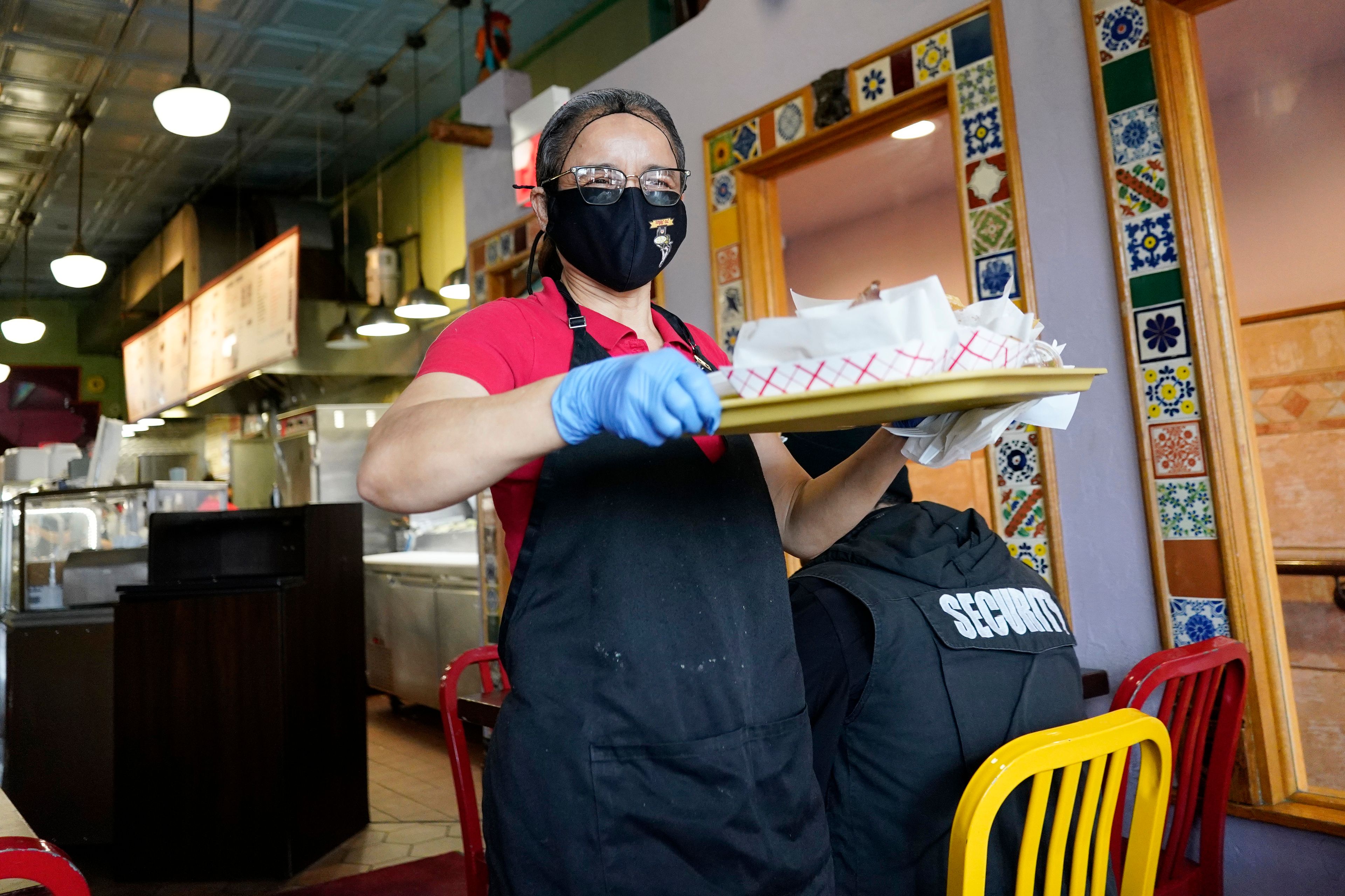Restaurant-based programs feed seniors’ social lives
Government aid has provided some eateries the opportunity to give back
GOFFSTOWN, N.H. — A group of friends and neighbors meets for a weekly meal, choosing from a special menu of nutritious foods paid for by social programs meant to keep older adults eating healthy.
They’re all older than 60, and between enjoying butternut squash soup, sandwiches, oats and eggs, they chat and poke fun about families, politics and the news of the day.
But if you’re imagining people gathering for lunch in a senior center, think again.
Long before COVID-19 put a pause on social gatherings, some senior centers were losing their lunch appeal. Others didn’t reopen after the pandemic.
Enter this elegant solution that’s gained popularity: give some of the federal and state money set aside to feed seniors to struggling restaurants and have them provide balanced meals with more choices, flexible timing and a judgment-free setting that can help seniors get together to chat and stem loneliness.
“Isolation is the new pandemic,” said Jon Eriquezzo, president of Meals on Wheels of New Hampshire’s Hillsborough County, which runs one such program, in addition to delivering meals to homebound seniors and senior centers. “Knocking on doors and seeing somebody who’s homebound is helpful. But getting people out to do this — the mutual support — you can’t beat that.”
Seniors are changing. They may still be working, taking care of grandchildren, and fitting in medical appointments, unable to show up at a set time for lunch or dinner. And after years of cooking for others, it’s nice to be able to sit at the restaurant and order a meal.
Some restaurant programs target seniors in rural communities. Others benefit people with limited access to transportation. Some are geared toward minority communities.
“Everybody does something a little bit different when they’re having a gap in services,” said Lisa LaBonte, a nutrition consultant based in Connecticut.
According to information compiled by Meals on Wheels America, one in four Americans is at least 60 years old, with 12,000 more turning 60 every day. Those on fixed incomes also are living longer with less money; one in two seniors living alone lacks the income to pay for basic needs.
Debbie LaBarre looks forward to the weekly gathering with her pals at a bright, bustling restaurant a short drive from her New Hampshire apartment. The special menu at the White Birch Eatery in Goffstown lists the calories, carbohydrates and sodium content for the meals, which have to meet a dietician-approved one-third of the USDA recommended daily requirements for adults under the federal Older Americans Act Nutrition Program. LaBarre and others sign up for the program and swipe credit- and keychain-style cards with QR codes for their allotted meals. There’s no charge for the meals, but donations are encouraged.
Even though she’s eating out more, LaBarre, 67, lost weight as she prepared for a recent surgery. But what’s most important for LaBarre is that she’s interacting with others. Retired after years working as a plumbing and heating business office manager, she’s concerned about Alzheimer’s disease.
“My mother had it, and she was always in the house. She never left,” she said. “I’m deathly afraid of it, so I said I guess I’m going to be as social as I can be.”
LaBarre takes a friend — a recent widower who is blind — to a different restaurant in Merrimack, N.H., that participates in the program.
“He says, ‘I never go out unless you take me,’ ” LaBarre said.
From a nutrition standpoint, “we eat better in groups,” nutrition consultant Jean Lloyd said. “Studies are out there that we eat healthier surrounded with people who eat healthy. And older adults are a vulnerable population.”
She cited one from 2020 about the health impact of loneliness on seniors. Recently, the U.S. surgeon general noted that widespread loneliness in the U.S. poses health risks as deadly as smoking up to 15 cigarettes daily.
The program focuses on goals of the wide-ranging Older Americans Act — to reduce hunger and food insecurity and promote the socialization, health and well-being of seniors.
Back in the 1980s, the restaurant was considered a little-explored, unpopular option to the traditional meal gatherings at senior centers and church basements. As of early this year, there were at least 26 states where some restaurants and other food providers partnered locally with an area agency on aging or a nonprofit such as Meals on Wheels.
“We get to see people and check in on them and they bring new friends, and we get to meet all new faces, sometimes,” said Cyndee Williams, owner of the White Birch Eatery, which opened in March 2020, right before the pandemic shut down everything. It restarted limited operations that summer. “And then, while we have a small profit margin, that helps us, too. It keeps my staff here and working.”
Restaurant partnerships in New Hampshire and in states like South Carolina, Iowa, and New Jersey, for example, started as COVID-19 restrictions were being lifted, along with the urgency of curbside pickups. Meanwhile, communities in Massachusetts, upstate New York, and northern California, which have established, pre-pandemic programs targeting rural areas and ethnic communities, are seeing additional restaurants coming on board.
“The pandemic had created an opportunity for us because it just made everyone aware of the need to think in a different way, to not provide services the way they always had in the past,” said Edwin Walker, deputy assistant secretary for aging under the Department of Health and Human Services.
Some programs offer grab-and-go options for seniors, grocery dining services, food trucks, hospital facilities, and catering at senior centers and other community locations in addition to or in place of in-house restaurant dining.
The partnerships originate at the local level. The federal Administration for Community Living, which oversees the nutrition services program and provides grants for innovative projects, does not keep data on how many restaurants and people take part and overall costs. It is working on a research project to learn more about them.
Federal funds are distributed to states based on a formula. States coordinate with local area agencies on aging and related nonprofits to distribute funds, and states provide matching funds for some programs. Nonprofits also seek out grants and donations.
Programs target services to people with the greatest economic or social need, such as low-income and minority populations, rural residents, and those with limited English proficiency.
The programs have to adjust to costs of food and labor, which can be challenging. The restaurants are reimbursed, but the funding sources are limited, especially as COVID-related emergency money has come to an end.
“For every meal we serve, we get $8.11,” Eriquezzo said. “The meal costs us $13. We suggest a $4 donation. Even if we get donations, we’re still short 80 cents.”
Restaurants might need to adjust menus, perhaps by offering smaller portion sizes, lowering the maximum monthly meals to save money and more specifically target who is using the meal programs the most.
Still, partnering with the restaurants costs less than contracting with a town hall or a church for the community dining option, said Janet Buls, nutrition director, Northeast Iowa Area Agency on Aging.
Bents Smokehouse & Pub in Westgate, Iowa, population 200, was the first restaurant in Bul’s territory to sign on after cooking meals for Meals on Wheels recipients during the worst of the pandemic.
Before any of that happened, though, times were tough.
“We would sit here all day and not even have 100 bucks in the till,” restaurant owner Sheila Bents said. “They saved us.”
And it’s saving seniors, too.
Robert Mays, 65, started going with his wife and mother-in-law to the The Lizard’s Thicket in Columbia, S.C., for weekly “Senior Lunch Bunch” gatherings.
“It allowed people living in the same neighborhood that normally don’t see one another and even different races to come together to find out that we’re way more alike than we are different,” he said.














